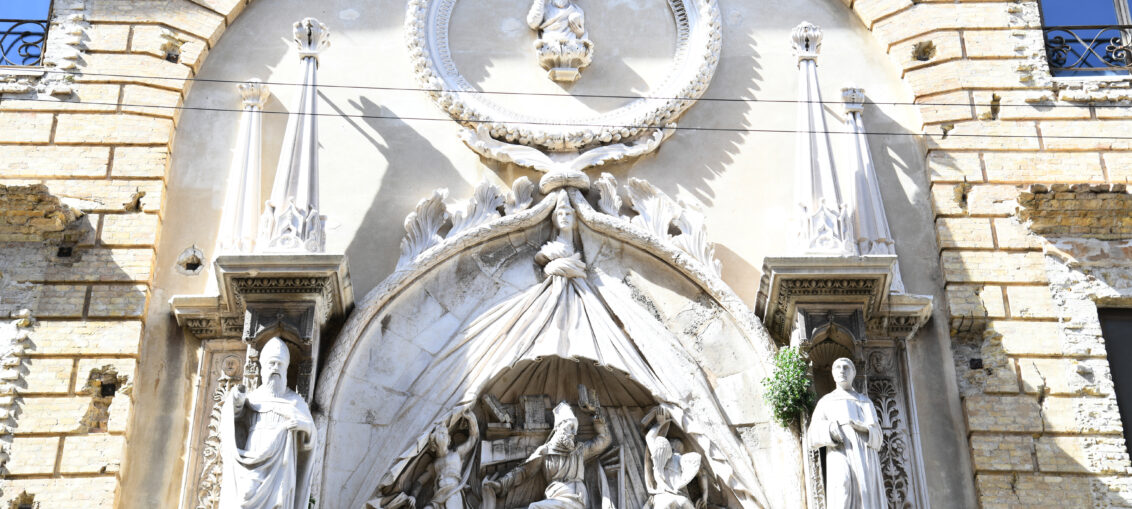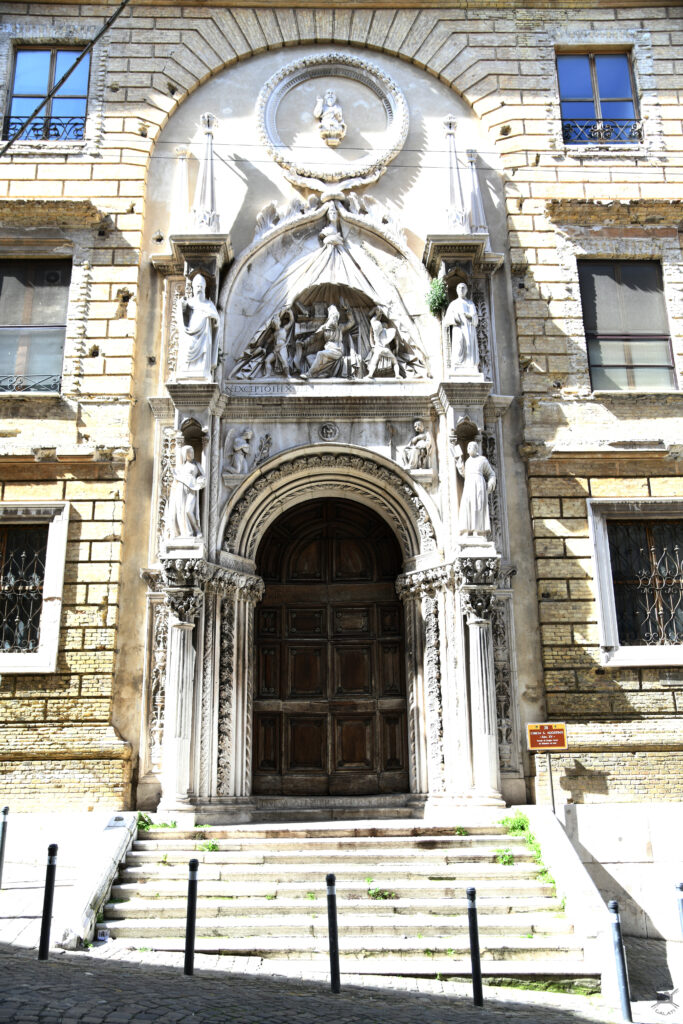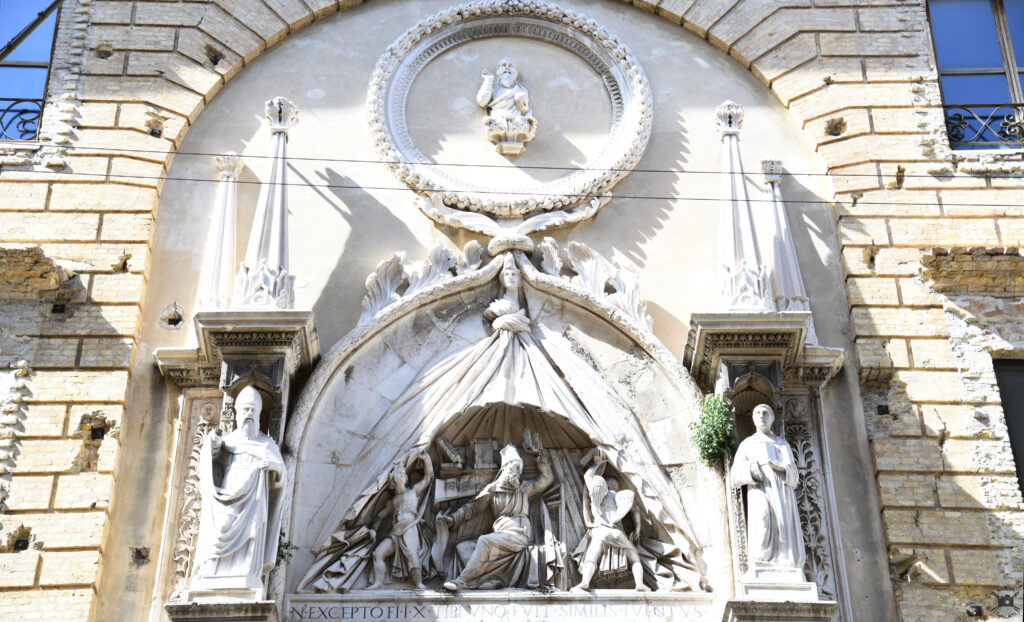
Un antico complesso dedicato a S. Agostino era sul Colle Astagno, a Capodimonte, anteriormente al 1532, anno in cui venne demolito per la realizzazione della Rocca del Sangallo.
Il complesso di S. Agostino di Capodimonte era formato da una piccola chiesa ed una piccola abitazione che gli Agostiniani sostituiranno nel 1339 con il più grande complesso che erigeranno nel piano della città, in luogo più centrale e di maggior capienza, e fu terminato verso la fine del sec. XV.
Dell’antica chiesa oggi resta solo il portale ad opera dell’artista dalmata Giorgio Orsini, detto Giorgio da Sebenico, che tuttavia non lo terminò, in cui si fondono armonicamente elementi gotici e rinascimentali; su di esso si trovano le statue che raffigurano Santa Monica e San Nicola da Tolentino, San Simpliciano e il beato Agostino Trionfi. I lavori furono conclusi nel 1494 da Michele di Giovanni da Milano e Giovanni Veneziano.
Rinnovata nel 1764 da Luigi Vanvitelli, nell’ambito di un ampio intervento architettonico ed urbanistico che interessò la città adriatica a partire dal quarto decennio del sec. XVIII, la chiesa anconitana presenta nel suo interno settecentesco vivaci stucchi dello svizzero Giacomo Cantoni e alcune grandi tele del Cades.
Dopo il 1860, con la secolarizzazione operata dall’Unità d’Italia, l’edificio venne profondamente modificato nei suoi esterni, con la separazione dell’area absidale per esigenze di viabilità (e l’adattamento dell’abside come vano scale di un edificio di abitazioni distrutto poi nella seconda guerra mondiale), la troncatura del campanile, la ridefinizione dei prospetti in forma di palazzo quale sede della Caserma Cialdini, fino alla distruzione della facciata con sola salvaguardia del ricco portale e del portone ligneo inquadrato nel vano arcuato di una parete a finto bugnato. Conseguentemente anche l’interno si presenta ora frazionato in piani e locali, con la completa ed irreversibile cancellazione delle orditure architettoniche vanvitelliane e la dispersione degli arredi fissi e mobili in altre chiese cittadine e del circondario; i dipinti sono parzialmente ora esposti alla Pinacoteca Civica “F. Podesti”
Attualmente l’ex chiesa di Sant’Agostino è sede della Sala Museale Contrammiraglio Guglielmo Marconi, dedicata alla storia delle telecomunicazioni e della radio in particolare; la sala museale si articola su 4 ambienti principali inseriti nel vecchio chiostro degli agostiniani. L’idea della mostra permanente, nasce dal fatto che Guglielmo Marconi condusse nel 1904 alcuni importanti esperimenti di trasmissione radiotelegrafica proprio ad Ancona, nei pressi del Vecchio Faro e del Colle dei Cappuccini Un tributo al grande fisico italiano, che fu anche ufficiale della Marina Militare Italiana e a lungo collaborò con essa.
Per ulteriori informazioni sulla Sala Museale visita il sito Sala Marconi
Aperto su prenotazione
Telefono: +39 071 5931619

Facciata Chiesa Sant’Agostino

Chiesa Sant’Agostino – via Cialdini 1
Church of Sant’Agostino
An ancient church dedicated to St. Augustine used to be on the Astagno hill, at Capodimonte. In 1532 it was demolished in order to build the Sangallo Fort. The complex of St. Augustine in Capodimonte was formed by a small church and a small house. This was already replaced by the Augustinians in 1339, by a larger complex built inside the city, in a more central and larger location. This building was finished around the end of the 15th century. Of the ancient church, today only the entrance remains. It was made (though left unfinished) by the Dalmatian artist Giorgio Orsini, also called Giorgio da Sebenico, mixing harmoniously gothic and renaissance elements. All around the portal are statues depicting: St. Monica and St. Nicholas of Tolentino, St. Simpliciano and Blessed Agostino Trionfi. The work was completed in 1494 by Michele di Giovanni da Milano and Giovanni Veneziano. The church was modified in 1764 by Luigi Vanvitelli, within the context of a large architectural and urban renovation of Ancona since the fourth decade of the 18th century. In that period the interior of the church was covered with bright plaster by the Swiss artist Giacomo Cantoni, and
enriched with paintings by Cades. After 1860, the building was confiscated by the newborn Italian state, and altered in its exterior: the apse was parted for the needs of the road (and the apse itself adapted into a staircase for a different building, then destroyed in World War II), the belltower was shortened, the exterior destroyed and redesigned, in order to become the Cialdini Barracks. Only the portal and the wooden door were saved, enclosed in a fake bossage wall.
Consequently also the interior is now divided into floors and rooms, with the full and irreversible destruction of the architectural frameworks by Vanvitelli and the dispersion of furniture and decorations, moved to other churches of the city and surroundings; some of the paintings are now exposed in the town gallery “F. Podesti”. Today the former church is the seat of the museum “Admiral Guglielmo Marconi”, dedicated to the history of telecommunications, especially the radio. The museum hall is divided into 4 main areas, included in the old cloister of the church. The idea of a permanent exhibition comes from the fact that Guglielmo Marconi made some important transmission experiments in Ancona in 1904, somewhere around the Old Lighthouse and the Cappuccini hill. A tribute to the great Italian physicist, who was also an official of the Italian Navy.
For more information about the Museum, visit the website
Museum hall Admiral Guglielmo Marconi
Chiesa di Sant’Agostino – via Cialdini 1
Open only on reservation
Phone: 071 5931619
Kirche St. Augustinus
Ein antike St. Augustinus gewidmete Ort war einst auf dem Hügel Astagno, in Capodimonte. Im Jahr 1532 wurde er abgerissen, um das Fort Sangallo zu bauen. Der Komplex St. Augustinus in Capodimonte bestand aus einer kleinen Kirche und einem kleinen Haus. Er wurde bereits 1339 von den Augustinern mit einem größeren Komplex in der Stadt ersetzt.
Der neue Ort war zentraler und größer. Dieses Gebäude wurde gegen das Ende des 15. Jahrhunderts abgeschloßen. Jetzt bleibt nur noch der Eingang der alten Kirche. Sie ist das (unvollendete) Kunstwerk des dalmatinischen Künstlers Giorgio Orsini (auch Giorgio da Sebenico benannt) und vermischt harmonische und gotische Elemente aus der Renaissance. Rund um das Portal sind Statuen, die stellen dar: St. Monika und St. Nikolaus von Tolentino, St. Simplicianun und Seliger Agostino Trionfi. Das Werk wurde 1494 von Michele di Giovanni von Milano und Giovanni Veneziano ergänzt. Die Kirche wurde 1764 von Luigi Vanvitelli im Umfeld von einem Stadtumbau renoviert.
Diese große Architektur- und Stadterneuerung von Ancona began in dem vierten Jahrzehnt des achtzehnten Jahrhunderts. In dieser Zeit wurde das Innere der Kirche mit hellem Putz von der Schweizer Künstler Giacomo Cantoni abgedeckt, undmit großen Gemälden des Malers Cades bereichert. Nach 1860 wurde das Gebäude von dem neugeborenen italienischen Staat konfisziert und seine Außenseite verändert: die Apsis wurde aufgrund der Befahrbarkeit getrennt (und in eine Treppe eines anderen Gebäude verwandelt. Dann wurde sie im Zweiten Weltkrieg zerstört); der Glockenturm wurde verkürzt, die Fassade zerstört und in Form eines Palastes neu gestaltet. Die Kirche wurde zum Sitz der Kaserne Cialdini. Nur das Portal und die Holztür wurden gerettet, und von einem falschen Bossenwerk umrahmt.
Folglich ist auch das Innere in Etagen und Räume unterteilt. Wegen den vollständigen und irreversiblen Zerstörungen der architektonischen Struktur Vanvitellis und dem Verlust von Möbeln und Dekorationen, wurden die in andere Kirchen in der Stadt und Umgebung getragen. Die Bilder werden nun teilweise in der Stadtgalerie “F. Podesti” ausgestellt. Heute ist die ehemalige Kirche der Sitz des Museums “Admiral Guglielmo Marconi”, der zu Geschichte der Telekommunikation und Radio, gewidmet ist. Die Museumshalle gliedert sich in vier Hauptbereiche, die dem alten Kloster der Kirche gehörten. Die Idee eines Dauerausstellung ergibt sich aus der Tatsache , dass Guglielmo Marconi einige wichtige Übertragungsexperimente in Ancona im Jahre 1904, irgendwo um den alten Leuchtturm und Colle dei Cappuccini, durch führte. Eine Hommage an den großen italienischen Physiker, der auch Offizier der italienischen Marine war.
Weitere Informationen über das Museum finden Sie auf die Website
Museum Halle Admiral Guglielmo Marconi
Augustine Church St. – über Cialdini 1
Geöffnet nur auf Reservierung
Tel.: 071 5931619
